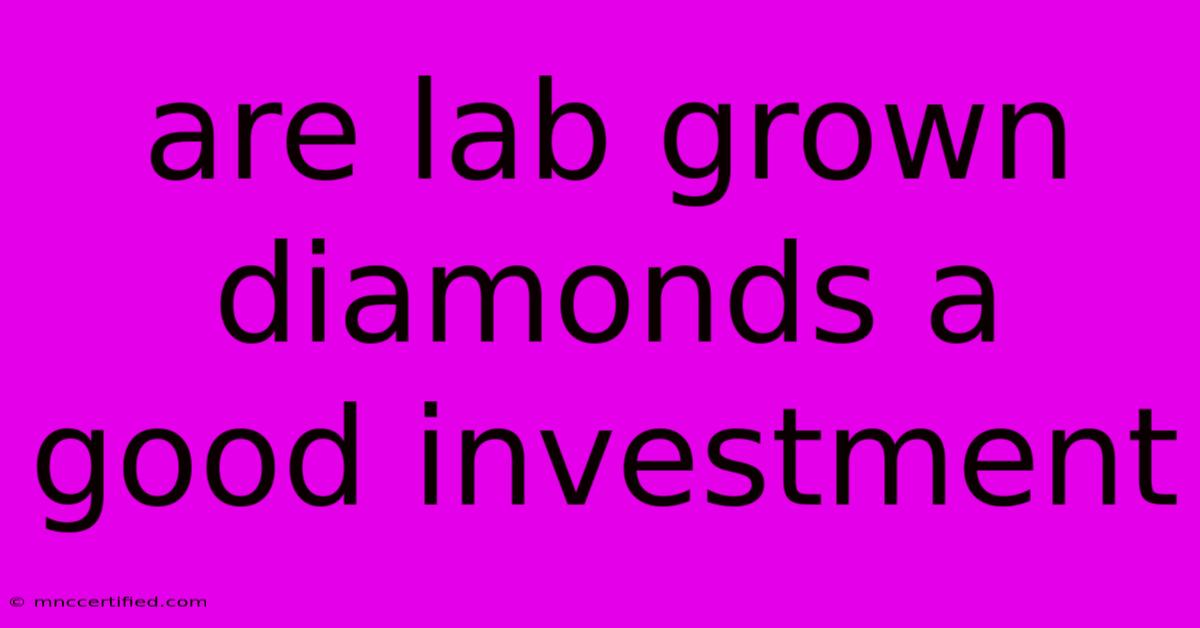Are Lab Grown Diamonds A Good Investment

Table of Contents
Are Lab-Grown Diamonds a Good Investment? A Comprehensive Look at the Sparkling Truth
The diamond industry is undergoing a dramatic shift. Lab-grown diamonds, created in controlled environments, are increasingly popular, offering an ethical and affordable alternative to mined diamonds. But are they a good investment? This article delves into the complexities of the lab-grown diamond market, exploring both the potential benefits and risks.
Understanding the Basics: Lab-Grown vs. Mined Diamonds
While chemically identical, lab-grown diamonds are created in a laboratory using advanced technology. These diamonds are essentially "grown" from tiny seed crystals in a high-pressure, high-temperature environment. Mined diamonds, on the other hand, are extracted from deep within the Earth's crust.
Here's a quick comparison:
Lab-Grown Diamonds
- Origin: Created in a laboratory
- Ethical considerations: No environmental damage or human rights concerns
- Cost: Typically cheaper than mined diamonds
- Availability: More readily available due to controlled production
- Quality: Often higher quality and consistency than mined diamonds
Mined Diamonds
- Origin: Extracted from the Earth
- Ethical considerations: Potential environmental and social impacts
- Cost: Generally more expensive than lab-grown diamonds
- Availability: Limited supply based on natural resources
- Quality: Can vary widely due to natural processes
The Investment Case for Lab-Grown Diamonds
The allure of lab-grown diamonds as an investment is undeniable. Here's why:
- Lower Entry Point: The price advantage of lab-grown diamonds makes them accessible for investors with a smaller budget.
- Potential for Growth: As the lab-grown diamond market continues to expand, demand is expected to rise, potentially leading to price appreciation.
- Sustainability and Ethical Appeal: Growing consumer awareness of ethical sourcing is fueling demand for lab-grown diamonds, which are free from the environmental and social issues associated with mining.
Factors to Consider Before Investing
While the potential for profit is appealing, several factors should be considered before investing in lab-grown diamonds:
- Lack of Established Resale Market: The lab-grown diamond market is still relatively new, and a well-established resale market hasn't yet emerged. This can make it challenging to sell your diamonds quickly or for a fair price.
- Brand Reputation: Not all lab-grown diamond companies are created equal. Reputable brands with established track records and industry certifications are crucial for maintaining value.
- Diamond Certification: Ensure your lab-grown diamonds are certified by reputable labs like GIA or IGI. This certification helps establish the diamond's quality and origin, adding to its value.
- Market Volatility: As with any investment, the lab-grown diamond market is susceptible to fluctuations. Factors like technological advancements, market trends, and consumer demand can influence pricing.
Alternatives to Consider
Investing in lab-grown diamonds is just one option. Other avenues to explore include:
- Investing in Diamond Mining Companies: This strategy offers exposure to the broader diamond market, but comes with the inherent risks associated with traditional mining operations.
- Diamond ETFs: Exchange-traded funds (ETFs) offer a diversified approach to investing in the diamond industry, providing exposure to a basket of diamond-related companies.
Conclusion: Weighing the Risks and Rewards
Whether or not lab-grown diamonds are a good investment depends on your individual financial goals, risk tolerance, and investment strategy. While the potential for growth and ethical appeal are attractive, the lack of a well-developed resale market and market volatility should be carefully considered.
Thorough research, understanding the market dynamics, and consulting with financial advisors are essential steps before making any investment decisions.
Remember, investment decisions should always be made with careful consideration and a clear understanding of the potential risks involved.

Thank you for visiting our website wich cover about Are Lab Grown Diamonds A Good Investment. We hope the information provided has been useful to you. Feel free to contact us if you have any questions or need further assistance. See you next time and dont miss to bookmark.
Featured Posts
-
Is Medical And Health Insurance The Same
Nov 08, 2024
-
Is Owning An Insurance Agency Profitable
Nov 08, 2024
-
Reds Trio Progressing Towards Return
Nov 08, 2024
-
Bonding Insurance For A Roofer In Texas
Nov 08, 2024
-
Workers Compensation Insurance Affidavit
Nov 08, 2024